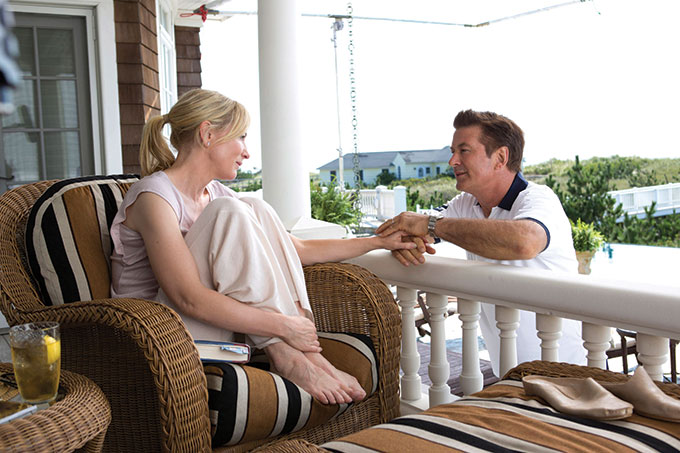Blue Jasmine
by George Sax

Stella! Ste... I mean, Ginger!
Blue Jasmine
There are at least three surprising things about Woody Allen’s Blue Jasmine. One is that he felt moved to make it in the first place. The movie is obviously in some sense a response to the recent Wall Street debacle and crisis. More specifically, he seems to have in mind Bernard Madoff’s giant, Ponzi-structured swindle. Not that the movie’s couple living high off the dirty proceeds of a financial shell game, Jasmine and Hal (Cate Blanchett and Alec Baldwin), resemble the Madoffs. They’re much younger and better-looking, and they’re apparently not Jewish. The world of national social and economic dislocations isn’t, to say the least, Allen’s customary creative stomping ground.
Even more curious is Jasmine, his delusionally narcissistic central character. He’s all too obviously modeled her after Tennessee Williams’s frail Blanche DuBois from his play A Streetcar Named Desire (with perhaps a touch of Williams’ Amanda Wingfield from The Glass Menagerie).
The combination of Allen and Williams gives us even more reason for pause. The idea of the whiny, querulous and absurdist jokester having an affinity for the poet of the romantically forlorn is a little startling. Who knew?
Which brings us to that third surprise: The unsettling critical approval the movie has generally been getting. There’s broad agreement among reviewers that Allen has nicely succeeded in imagining and producing a riveting portrait of the psychological deterioration of a woman who’s riding the elevator down from the commanding social heights of privilege purchased with her husband’s massively corrupt dealing. And there’s more than a grain of truth in these assessments. The collaboration of Allen and Blanchett has resulted in an eminently watchable, technically sharp, engaging performance. It’s impressive, no doubt about it. What’s less obvious is whether it and the film give us a persuasive human likeness, and whether that film really works.
As it happens, we don’t have to feature Allen as a disciple of Oliver Stone. He has next to nothing to say about Wall Street’s meltdown, using it only as a pretext for his focus on Jasmine’s personality and plight. Allen plays his cards at the very outset of Blue Jasmine when he shows us Jasmine subjecting her distressed airplane seatmate to a manically self-absorbed commentary on her recent life and tribulations, a monologue that ends only when the poor lady beats a hasty retreat from the airport luggage carousel. This brief intro sets up the movie’s tonal instability. It is uncomfortably funny, and if Allen had extended this feeling throughout, he just might have brought it off. But he didn’t. The comic and the dramatically serious share uncomfortably close quarters, neither complementing the other.
Jasmine has flown cross-country to San Francisco to sponge off her half-sister Ginger (Sally Hawkins), a grocery store cashier. (The juxtapositioning of the hard-pressed but stubbornly guileless Ginger and this soigne, posturing-if nutty-fugitive from Silk Stocking Manhattan is one of the first jarring implausibilities.)
Like Williams’ fragile, self-deluding Blanche, Jasmine is seeking refuge and a new start, on her terms, in an unlikely place. And like Blanche, she’s visibly unraveling. Owen Glieberman’s reaction in Entertainment Weekly is typical enough: “…Allen, pushing the Blanche figure front and center, gives the action a gripping contemporary resonance and flow.” And he claims the movie “is rich with class tension.” Similar claims abound, but they seem to be about another picture, to me.
Taking the second point first, Allen’s depiction of working-class people is cluelessly condescending. Start with Ginger’s supposedly downscale Mission District apartment. Designed by Santo Loquasto, the accommodations are especially depressing to the snooty Jasmine, despite the fireplace, pastel colors, and natural light (not to mention the wine rack on the kitchen counter!). In reality, it could be the abode of a young law firm associate, if she was lucky.
More crucially, Allen plays Ginger and the people in her circle like escapees from Ralph Kramden or Archie Bunker’s milieu: cheerfully witless, without worldly knowledge, or conversational graces. There’s even a milder subsidiary stand-in for Blanche’s brutish nemesis, Stanley Kowalski, in Ginger’s auto mechanic boyfriend Chile (Bobby Cannavale). (This would make Ginger Streetcar’s Stella, I suppose.)
But the primary problem is Allen’s concept. His Jasmine is a pastiche, a rather pointless riffing on Williams’s model. Williams, for all the reputed floridness of his work, made Blanche a figure of lyrical poignance, and imbued his play with an implicit lament for the world’s sometimes brutal intolerance of protective illusions. And there was, of course, sympathy, something Allen can’t quite muster.
It’s really indisputable that he and Blanchett have produced a compelling, tour de force portrayal of a woman descending into her own prejudices and delusions. (As has frequently been noted, Blanchett played Blanche on the New York stage several years ago.) But Allen undermines the structure of her performance with his jokey intrusions. Yet, he’s also piled on such sobering material as suicide, mental illness, drug use, and large-scale finance-industry crimes. What gives?
Maybe Blue Jasmine exhibits two Allens: the original gagman and whiny wise guy, and the one who’s been known to aspire to high brow dramatic cred. Two Allens or one, this movie doesn’t work.
Watch the trailer for Blue Jasmine
|
Issue Navigation> Issue Index > v12n33 (Week of Thursday, August 15) > Film Reviews > Blue Jasmine This Week's Issue • Artvoice Daily • Artvoice TV • Events Calendar • Classifieds |









 Current Issue
Current Issue